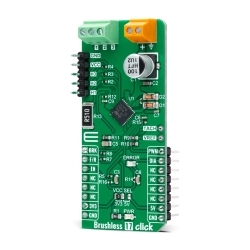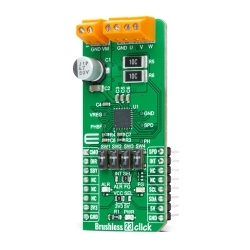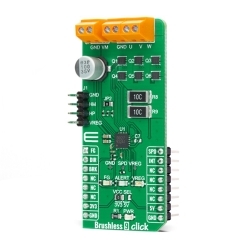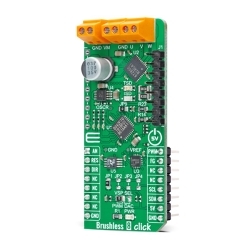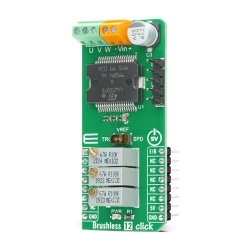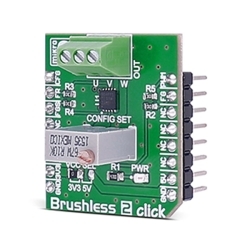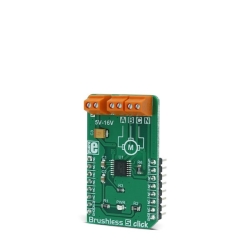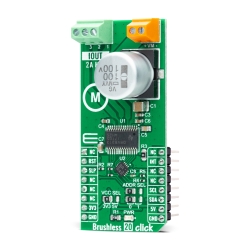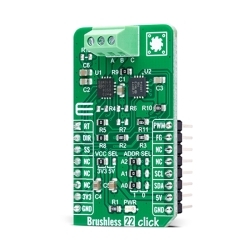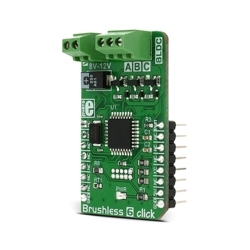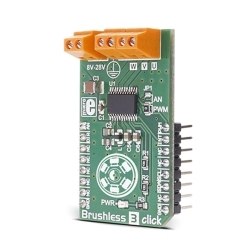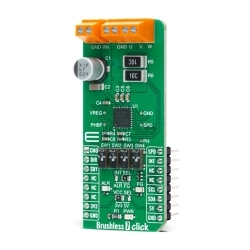MIKROE Brushless 21 Click
Brushless 21 Click is a compact add-on board suitable for controlling brushless DC (BLDC) motors with any MCU.
Product Overview
Brushless 21 Click is a compact add-on board suitable for controlling brushless DC (BLDC) motors with any MCU. This board features the AMT49400, an advanced 3-phase, sensorless BLDC motor driver with integrated power MOSFETs from Allegro Microsystems. The AMT49400 is rated for an operating voltage range from 4V to 16V. Motor rotation speed is controlled by applying a duty cycle command to the PWM input, while a simple I2C interface is provided for setting motor-rated voltage, rated current, rated speed, resistance, and startup profiles. Besides, it features additional diagnostic circuits and drive-control functions such as motor lock detection and over-current (short) protection. This Click board™ makes the perfect solution for home appliances such as pumps and cooling fans, industrial equipment, and more.
Brushless 21 Click is supported by a mikroSDK compliant library, which includes functions that simplify software development.
Brushless 21 Click as its foundation uses the AMT49400, a three-phase BLDC controller with integrated MOSFETs from Allegro Microsystems. The integrated field-oriented control (FOC) algorithm achieves the best efficiency and dynamic response and minimizes acoustic noise. Also, Allegro’s proprietary non-reverse startup algorithm improves startup performance. The BLDC motor, connected to the terminals labeled as U, V, and W, will start towards the target direction after power-up without reverse shaking or vibration. The Soft-On Soft-Off (SOSO) feature gradually increases the current to the motor at ON command (windmill condition). It gradually reduces the current from the motor at the OFF command, further reducing the acoustic noise and operating the motor smoothly.
This Click board™ allows interface selection to communicate with MCU. The selection between PWM and I2C interface can be made by positioning SMD jumpers labeled as COMM SEL to an appropriate position. Note that all the jumpers' positions must be on the same side, or the Click board™ may become unresponsive. While the I2C interface is selected, setting motor-rated voltage, rated current, rated speed, resistance, and startup profiles are allowed via the EEPROM programmability. On the other side, the motor speed is controlled by applying a duty cycle command to the PWM input pin of the AMT49400.
Alongside the PWM pin from the mikroBUS™ socket, this Click board™ also has the Enable pin labeled as EN and routed to the CS pin of the mikroBUS™ socket to optimize power consumption used for power ON/OFF purposes. The FG pin, routed on the INT pin of the mikroBUS™ socket, provides motor speed information to the system, such as motor lock detection. This feature monitors the motor position to determine if the motor is running as expected. If a lock condition is detected, the motor drive will be disabled for 5 seconds before an attempted auto-restart.
This Click board™ can operate with both 3.3V and 5V logic voltage levels selected via the VIO SEL jumper. It allows for both 3.3V and 5V capable MCUs to use the communication lines properly. Additionally, there is a possibility for the AMT49400 power supply selection via jumper labeled as VBB SEL to supply the AMT49400 from an external power supply terminal in the range from 4V to 16V or with 5V from mikroBUS™ power rail. However, the Click board™ comes equipped with a library containing easy-to-use functions and an example code that can be used, as a reference, for further development.
Features & Specs
- Interface: I2C, PWM
- Compatibility: mikroBUS™
- Dimensions: 42.9 x 25.4mm
- Input Voltage: 3.3V or 5V, External
- Supply Voltage VIO: Min. 3.3V, Max. 5V
- External Supply Voltage VIN: Min. 4V, Max. 16V
- Operating Temperature Range: Min. -40°C, Typ. +25°C, Max. +105°C
- Maximum Output Current: 2A
Documentation
Customer Reviews
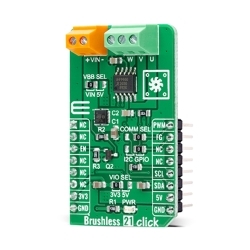
Stock and Customer Discounts
Available Discounts
- $14.20 | 25+ units
- $13.46 | 100+ units


